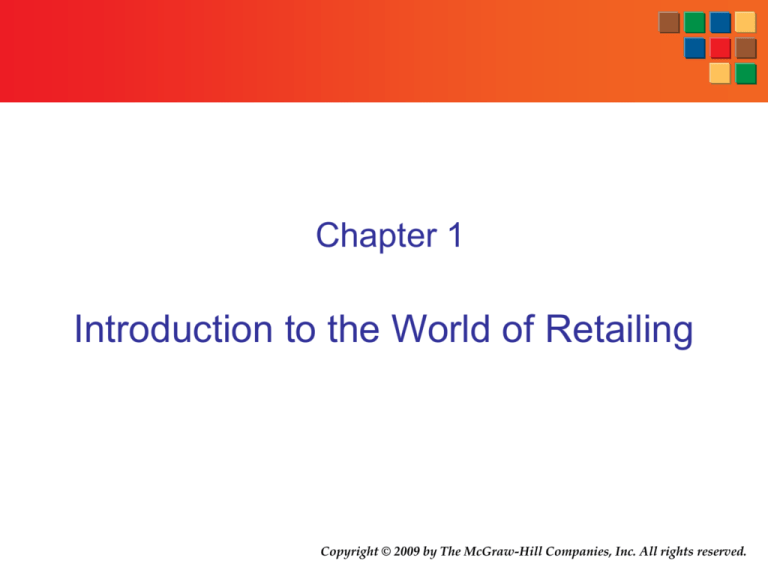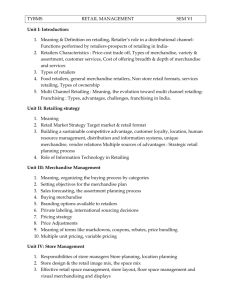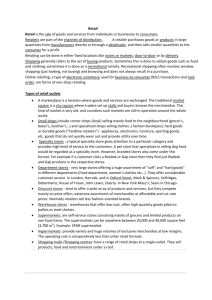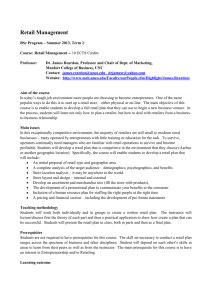
Chapter 1
Introduction to the World of Retailing
Copyright © 2009 by The McGraw-Hill Companies, Inc. All rights reserved.
1-2
The World of Retailing
Introduction to Retailing
Types of Retailers
Multi-Channel Retailing
Customer Buying Behavior
1-3
Questions
■
■
■
■
What is retailing?
What do retailers do?
Why is retailing important in our society?
What career and entrepreneurial opportunities
does retailing offer?
■ What types of decisions do retail managers
make?
1-4
What is Retailing?
Retailing – a set of business
activities that adds value to
the products and services
sold to consumers for their
personal or family use
A retailer is a business that
sells products and/or
services to consumers for
personal or family use.
1-5
Examples of Retailers
Retailers:
Kohl’s, Macy’s,
Wendy’s,
Amazon.com, Jiffy
Lube, AMC Theaters,
American Eagle
Outfitter, Avon, J.Crew
Firms that are retailers and wholesalers - sell to
other business as well as consumers:
Office Depot, The Home Depot, United Airlines, Bank of
America, Costco
1-6
Manufacturer’s Perspective
The Four P’s of Marketing
Retailers
the
Retailersare
are part
part of
of the
distribution
channel
distribution channel
Product
Price
Distribution
Promotion
1-7
Distribution Channel
1-8
Typical Supply Chain Network
Customers
Suppliers
Plants
Distribution
Centers
retailers
1-9
A Retailer’s Role in a Supply Chain
Retailers are the final business within a supply
chain which links manufacturers to consumers.
A Supply Chain is a set of firms that make and
deliver a given set of goods and services to the
ultimate consumer.
1-10
Manufacturing, Wholesaling and Retailing
Vertical Integration – firm performs more than one set of activities in
the channel
Ex: retailer invests in wholesaling or manufacturing
Backward Integration – retailer performs some distribution and
manufacturing activities
Ex: JCPenney sells Arizona jeans (Private Label)
Forward Integration – manufacturers undertake retailing activities
Ex: Ralph Lauren (New York Jones, Liz Claiborne) operates its
own stores
Large retailers engage in both wholesaling and retailing
Ex: Wal-Mart, Lowe’s, Safeway, Brown Shoe Company
1-11
Do Retailers Add Value?
Example
a box of crackers at a grocery store
costs $1 to manufacturer
sells at a price of $2
Retailers add significantly to the prices consumers face
Why not buy directly from the manufacturer?
Does that mean that grocery stores are very profitable?
1-12
Why Not Get Rid of the Middlemen?
Price to
Distributor
$1.00
$.85
$.15
Manufacturer
Distributor
Vendor
Wholesaler
Price to
Retailer
Price to
Consumer
$1.20
$2.00
$.70
Retailer
Consumer
1-13
Why Not Get Rid of the Middlemen?
Better services to
customers
More efficient
1-14
Music Industry Channel
Composer
Lyricist
Publisher
Record
Company
Artist
Music Retailer
Distributor
1-15
Cost for CD
Retailer
$5.00
Record Company
Manufacturing
.75
Distribution
1.50
Marketing
2.00
Coop advertising 1.00
Artist/Repertoire 1.00
Artist royalty
1.25
Lyricist
.75
Overhead/Profit 2.00
Total
• 4 out of 5 CDs fail to
make a profit
• $300,000 cost to
prepare a CD for
release
• 30,000 recording
artists
15.25
1-16
How Retailers Add Value
■ Provide Assortment
Buy other products
at the same time
■ Break Bulk
Buy it in quantities
customers want
■ Hold Inventory
Buy it at a
convenient place
when you want it
■ Offer Services
See it before you
buy; get credit;
layaway
Ryan McVay/Getty Images
1-17
How Retailers Add Value
The value of the product and service
increases as the retailer performs functions.
Bicycle can be
bought on credit or
put on layaway
Bicycle is featured
on floor display
Bicycle is offered in
convenient locations
in quantities of one
Bicycle is
developed in
several styles
Bicycle is developed
at manufacturer
1-18
Examples: How Retailers Add Values
BagBorrowerSteal.com
jewelry and bag rental; Get (not buy, but borrow) exactly what you
want
Home Depot
DIYer (Do-it-yourselfer); Learn how to do it yourself with in-store
clinics and online workshops
1-19
Social and Economic Significance of Retailing
Retail Sales:
Over $4.1 trillion in annual
U.S. sales in 2005
Employment:
Employs over 24 million
people in 2005
One of the largest sectors
for job growth in US
Social responsibility
Global player
1-20
Social responsibility
Corporate social responsibility
The voluntary actions taken by a
company to address the ethical,
social, and environmental impacts
of its business operations, in
addition to the concerns of its
stakeholders
Examples: Edun - a fair-trade fashion
brand by the U2 lead singer Bono
Starbucks: pays its farmers 42%
more than the commodity price of
Arabica coffee beans
Target: community giving programs
(5% of income, $3 million a week)
Retail companies give away 1.7% of
their profits, compared with about 0.9%
for companies in other industries
1-21
World’s 20 Largest Retailers in 2005
1-22
Structure of Retailing and Distribution Channels around the
World: The United States
The United States
CHINA
The nature of retailing and
distribution channels in the U.S.
is unique.
Has the greatest retail density
Has the greatest concentration of
large retail firms
Large enough to operate their
own warehouses, eliminating the
need for wholesaling.
The combination of large stores
and large firms result in a very
efficient distribution system.
1-23
Comparison of Distribution Channels
around the World
1-24
What have created these differences
in distribution systems?
Social &
Political
Objectives
China, India: To reduce unemployment by
protecting small businesses
EU: To protect small retailers
To preserve green spaces/town centers
Geography
Much lower population density in the US than in India,
China, and EU (where less low-cost real estate are
available for building large stores)
Market size
Large retail markets in US, India, China
Countries in EU – distribution channels and retail
chains operate in a single country (no economy of scales
to be achieved; trade barriers still exist)
1-25
Opportunities in Retailing:
Management opportunities
■ People with a wide range of skills and interests needed
because retailers’ functions include
Finance
Purchase
Accounting
Management information system (MIS)
Supply management including warehouse and
distribution management
Design and new product development
■ Financially rewarding
5-year salary of buyers: $50,000 - $60,000
5-year salary of store managers: $120,000 - $160,000
1-26
Nature of Retail Industry is Changing
To Today’s Retailer
Mom and Pop Store
1-27
Retailers are a Business Like
Manufacturers
Real Estate
Finance
Store Design
Promotion/Advertising
MIS
Loss Prevention
Operations
Human Resources
The McGraw-Hill Companies,
Inc./Andrew Resek, photographer
1-28
Retailing is a High Tech Industry
Selling Merchandise through the Internet
Using Internet to manage supply chains
Analyze POS data to tailor assortments to stores
Computer systems for merchandise planning and
tracking
1-29
Opportunities in Retailing:
Entrepreneurial opportunities
Wal-Mart: Sam Walton
■ Retailing provides opportunities for
people who want to start their own
business
■ Some of the world’s richest people
are retailing entrepreneurs
■ Examples of retailing
entrepreneurs
Sam Walton (Wal-Mart)
Jeff Bezos (Amazon.com)
Ingvar Kamprad (IKEA)
Anita Roddick (the Body Shop)
IKEA: Ingvar Kamprad
1-30
Career Opportunities in Retailing
Start Your Own Business
List of Retail Entrepreneurs on Forbes 400 Richest Americans
Walton Family (Wal-Mart)
Fisher (The Gap)
Wexner (The Limited)
Menard (Menard’s)
Marcus (The Home Depot)
Kellogg (Kohl’s)
Schulze (Best Buy)
Levine (Family Dollar)
Gold (99Cent Only)
1-31
Retail Management Decision Process
1-32
Strategic Vs Tactical Decisions
■
Doing the Right Thing (direction) vs.
Doing Things Right (execution)
■ Strategic Decisions Are:
Made Infrequently
Long-term
Require significant investment
Not easily reversed
■
Location, Organization Design, Information and
Distribution Systems, Customer Service
1-33
Retail Strategy
■ Need to identify the competition
intratype competition
(e.g., Dillard’s vs. JCPenney)
intertype competition
(e.g., Dillard’s vs. Wal-Mart)
■ Identifying customers
What are the significant
demographic and life-style
trends
Who are your target
customers
1-34
Retail Strategy
■ A retail strategy should identify
the target market
the product and service mix
a long-term comparative advantage
1-35
JC Penney’s Strategic Evolution(1)
Main Street (small town) private
label, soft goods (apparel, home
furnishings), decentralized retailer
Changes in environment -increased disposable income,
growth of suburbs, interstate
highway program
Emulate Sears in moving to
enclosed suburban malls
Add hard goods (appliances,
automotive)
Diversify – drug stores,
insurance, specialty stores
Develop catalog channel
1-36
JC Penney’s Strategic Evolution(2)
Focus on department store format
and soft goods develop electronic
retail channel
Mid-market, mall based department
store, between Wal-Mart/Target and
Macy’s/Dillards
Competition from Target, Kohl’s
Centralization to reduce cost,
increase responsiveness centralized buying, warehouse
delivery
Off the mall stores to increase
customer convenience
Improving store atmospherics
Upgrading merchandise offering
(e.g., Sephora, American Living by
Polo Ralph Lauren)
1-37
Wal-Mart’s Strategic Evolution
Small Town - Discount Store selling hard goods
and soft goods
limited service, efficient distribution
Enter suburban markets
Warehouse Clubs (Sam’s)
Supercenters
International Expansion
Supermarkets, neighborhood markets
1-38
Sears’ Strategic Evolution
Large number of merchandise categories -appliances, hardware, apparel
Malls evolved into places for buying soft goods,
hard goods sold at category killers
The Softer Side of Sears
Refocused on value -- Testing carts in stores
Acquired Lands’ End
Acquired by Kmart
1-39
Whole Foods Implementation
Strategy - organic and natural foods supermarket chain
Assortment beyond organic/natural foods
Private labels - Whole Food™, 360 Day Value™
Love, trust, and employee empowerment
Equality in compensation
1-40
Decision Variables for Retailers
Customer Service
Store Design
and Display
Retail
Merchandise
Assortment
Strategy
Pricing
Location
Communication
Mix
1-41
Wal-Mart’s Retail Mix
Customer
Service
Store Design
And Display
Location
Retail Strategy
Communication
Mix
Merchandise
Assortment
Pricing
1-42
Wal-Mart’s Retail Mix
Location Strategy
Free-standing Stores
Customer
Service
Store Display
And Design
Communication
Mix
Merchandise
Assortment
Pricing
1-43
Wal-Mart’s Retail Mix
Assortment Strategy
Customer
Service
Location
Large Number
of Categories
Store Design
and Display
Communication
Mix
Pricing
Few Items
in Each Category
1-44
Wal-Mart’s Retail Mix
Location
Customer
Service
Pricing Strategy
Merchandise
Assortment
Store Design
and Display
Communication
Mix
Low, EDLP
1-45
Wal-Mart’s Retail Mix
Customer
Service
Location
Communication Mix
Store Design
and Display
Merchandise
Assortment
Pricing
TV and Newspaper
Insert Ads
1-46
Wal-Mart’s Retail Mix
Store Design and Display
Customer
Service
Basic, Special
Displays
for Products
Location
Merchandise
Assortments
Communication
Mix
Pricing
1-47
Wal-Mart’s Retail Mix
Customer Service
Limited
Location
Merchandise
Assortment
Store Design
and Display
Pricing
Communication
Mix
1-48
Claire’s Retail Mix
Customer Service
Location
Merchandise
Store Design
and Display
Retail Strategy
Communication Mix
Assortment
Pricing
1-49
Claire’s Retail Mix
Location Strategy
Enclosed malls
Customer Service
Store Display
Merchandise
And Design
Assortment
Communication Mix
Pricing
1-50
Claire’s Retail Mix
Assortment Strategy
Customer Service
Location
Jewelry, accessories and
cosmetics for tweens and
Store Design
and Display
teens
Communication Mix
Pricing
1-51
Claire’s Retail Mix
Location
Pricing Strategy
Customer Service
Merchandise Assortment
Store Design
and Display
Communication Mix
Modest with Sales
1-52
Claire’s Retail Mix
Customer Service
Communication Mix
Location
Store Design
And Display
Merchandise Assortment
Pricing
TV and Magazine Ads
1-53
Claire’s Retail Mix
Store Design and Display
Customer Service
Bright, fashionable and fun
Location
Merchandise Assortments
boutique layout
Communication Mix
Pricing
1-54
Claire’s Retail Mix
Customer Service
Modest
Location
Merchandise Assortment
Store Design and Display
Pricing
Communication Mix
1-55
Macy’s Retail Mix
Customer Service
Location
Merchandise
Store Design
and Display
Retail Strategy
Communication Mix
Assortment
Pricing
1-56
Macy’s Retail Mix
Location Strategy
Enclosed Malls
Customer Service
Store Display
Merchandise
And Design
Assortment
Communication Mix
Pricing
1-57
Macy’s Retail Mix
Assortment Strategy
Customer Service
Location
Many Items in Apparel
Store Design
and Display
and Soft Home
Communication Mix
Pricing
1-58
Macy’s Retail Mix
Location
Pricing Strategy
Customer Service
Merchandise Assortment
Store Design
and Display
Communication Mix
Moderate with
Frequent Sales
1-59
Macy’s Retail Mix
Customer Service
Communication Mix
Location
Store Design
And Display
Merchandise Assortment
Pricing
TV, Newspaper Ads and
Special Events
1-60
Macy’s Retail Mix
Store Design and Display
Customer Service
Racetrack with Displays
Location
Merchandise Assortments
Communication Mix
Pricing
1-61
Macy’s Retail Mix
Customer Service
Modest
Location
Merchandise Assortment
Store Design and Display
Pricing
Communication Mix
1-62
Target’s Retail Mix
Customer Service
Location
Merchandise
Store Design
and Display
Retail Strategy
Communication Mix
Assortment
Pricing
1-63
Target’s Retail Mix
Location Strategy
Free-standing Stores
Customer Service
Store Display
Merchandise
And Design
Assortment
Communication Mix
Pricing
1-64
Target’s Retail Mix
Assortment Strategy
Customer Service
Location
Large Number of Categories
Store Design
and Display
Private Labels
Few Items in Each Category
Communication Mix
Pricing
1-65
Target’s Retail Mix
Location
Pricing Strategy
Customer Service
Merchandise Assortment
Store Design
and Display
Communication Mix
Low to Modest
1-66
Target’s Retail Mix
Communication Mix
TV and Newspaper
Insert Ads
1-67
Target’s Retail Mix
Store Design and Display
Customer Service
Location
Colorful, wide aisles displays
Merchandise Assortments
for products with a grid layout
Communication Mix
Pricing
1-68
Target’s Retail Mix
Customer Service
Limited
Location
Merchandise Assortment
Store Design and Display
Pricing
Communication Mix
1-69
Ethical Situations for a Retail Manager
Should a retailer sell merchandise that they suspect utilized
child labor?
Should it advertise that its prices are the lowest in an area
even though some items are not?
Should a buyer accept an expensive gift from a vendor?
Should salespeople use high-pressure sales when they know
the product is not the best for the customer’s needs?
Should a retailer give preference to minorities when making a
promotion decision?
Should a retailer treat some customers better than others?
1-70
Checklist for Making Ethical Decisions
1-71
You are Faced with an Ethical Decision:
What Can You Do?
Ignore your personal values and do what your
company asks you to do – you will probably feel
dissatisfied with your job .
Take a stand and tell your employer what you
think. Work to change the policies.
Refuse to compromise your principles – you
could lose your job!
1-72
Careers in Retailing
Career Opportunities
Store Management
Merchandise Management
Corporate Staff
1-73
Misconceptions About Careers in Retailing
■
■
■
■
■
■
■
■
■
College not needed
Low pay
Long hours
Boring
Dead-end job
No benefits
Everyone is part-time
Unstable environment
No opportunity for women and minorities
The McGraw-Hill Companies, Inc./Andrew Resek, photographer
1-74
Why You Should Consider Retailing
■ Entry level management positions:
Department manager or assistant buyer/planner
■ Manage and have P&L responsibility on your first job
■ Starting pay average with great benefits
■ Some retailers pay graduate school
■ No two days are alike
■ Buying and planning for financially analytically oriented
■ Management for people-people
1-75
Types of Jobs in Retailing
Most entry level jobs are in
store management or buying, but there’s…
-accounting and finance
-real estate
-human resource management
-supply chain management
-advertising
-public affairs
-information systems
-loss prevention
-visual merchandising
1-76








